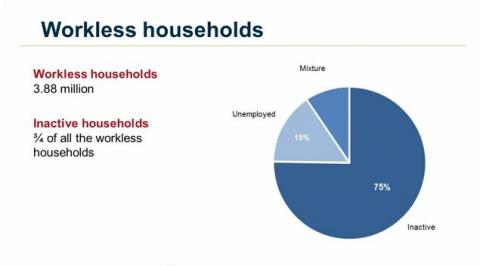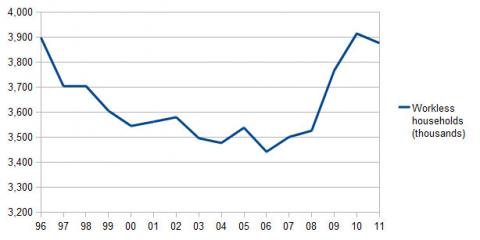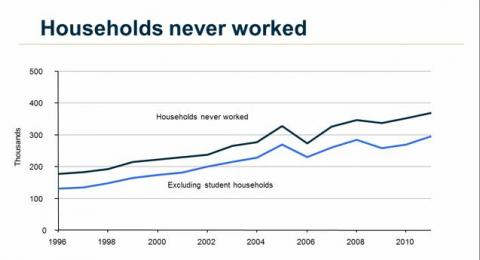
The publication of the Office  for National Statistics report on the subject of workless homes in Britain workless homes in Britain was a major story in many of the newspapers this morning.
for National Statistics report on the subject of workless homes in Britain workless homes in Britain was a major story in many of the newspapers this morning.
Though the figures were covered in a range of papers, the coverage in both the Daily Express and Daily Star referring to four million “scrounging families” prompted several Full Fact readers to ask us to check out the numbers.
So what do the stats show?
The two big figures that most newspapers seem to have picked up on is the fall in workless houses by 38,000 (a decrease of 0.3 per cent) and a rise in the number of households in which no one has ever worked by 18,000 up to 370,00.
A workless household is one in which at least one resident is aged between 16-64 and is not currently in employment. The term ‘household’ refers to a single person or a group of people living at the same address who live together. This is not necessarily, as some papers seem to suggest, the same as a ‘family’.
The ONS splits workless households into three types, unemployed, inactive and mixed. As the name suggests, unemployed houses have more than one 16-64 year old currently looking for work.
 An inactive household’s residents are either not looking or unable to work. A mixed household contains both types. Inactive households make up around 75 per cent of the total households.
An inactive household’s residents are either not looking or unable to work. A mixed household contains both types. Inactive households make up around 75 per cent of the total households.
Of inactive households 34 per cent are inactive as a result of long term sickness or disability. Furthermore, 24 per cent of this group is retired. Added is the fact that a proportion of these workless houses are likely to be students, although the ONS does not provide information on this.
Given these breakdown it would be misleading to give a blanket description of all these families as “scrounging” – as Full Fact haspreviously argued.
Indeed with regard to those who are workless as a result of long term sickness or disability, A recent Work and Pensions Select Committeereport called such language “irresponsible and inaccurate.”
Interestingly, and despite an increase in the overall number of households of around 10 per cent, the number of workless households have remained relatively stable since 1996. Over the last 15 years the number workless households was lowest in 2006 at 3,443,000 and highest in 2010 at 3,915,000. The recent rise in workless households can be traced back to a sharp increase at the beginning of the recession in 2008.
 Although there has been a slight dip in the number of workless households, this has been overshadowed in some of the newspapers by the rise in households in which no one has ever worked. The increase of around 18,000 households in the last year falling in this category seems to be part of an on going trend.
Although there has been a slight dip in the number of workless households, this has been overshadowed in some of the newspapers by the rise in households in which no one has ever worked. The increase of around 18,000 households in the last year falling in this category seems to be part of an on going trend.
As the Daily Express points out, the number of households in which no one has ever worked has increased by 125 per cent since 1996 from 178,000 to current levels of 370,000. This is a rise from 0.9 to 1.8 per cent of total UK households.
Whilst still a significant increase, many of the newspapers covering the story failed to emphasis the fact that these figures include student households. Excluding students brings the number down to 297,000.

So while the figures used in the reports are for the most part accurate, it is the language and the way they are presented that loses some of the nuance in the picture.
For further information on the report the ONS provides an interesting and highly informative video podcast giving a clear explanation of the findings.
Thank you Full Fact for showing The Daily Express up for the scum it is

4 Responses
Give us a “job” we can do that
Modern print journalism = Make shit up. I can invent vacuous discriminatory bullshit for half the money they pay these tossbags
That’s one for the CV is that. Then to tell the Jobcentre I want to apply for journalism jobs. “What makes you think you would be good at this job?” “I’m very good at lying, and I hate poor people and crips and foreigners, and I’m so bad at figures I could easily mangle any statistic to fit any situation.”
[…] into why that figure is misleading here (the work has already been done many times over, including here), the important thing is the attitude this type of headline breeds into a certain group of people […]